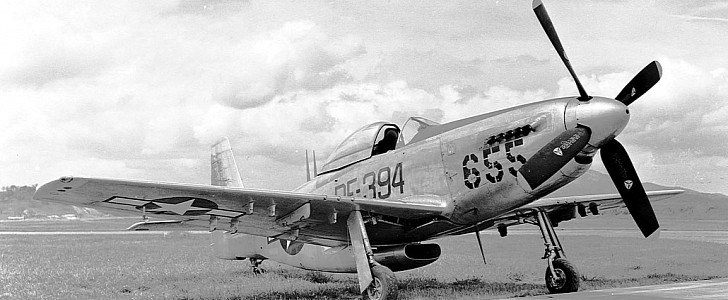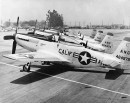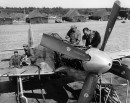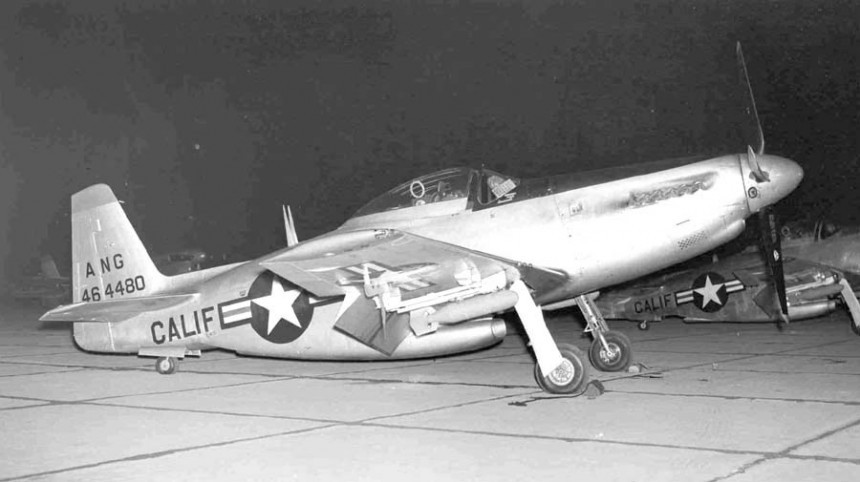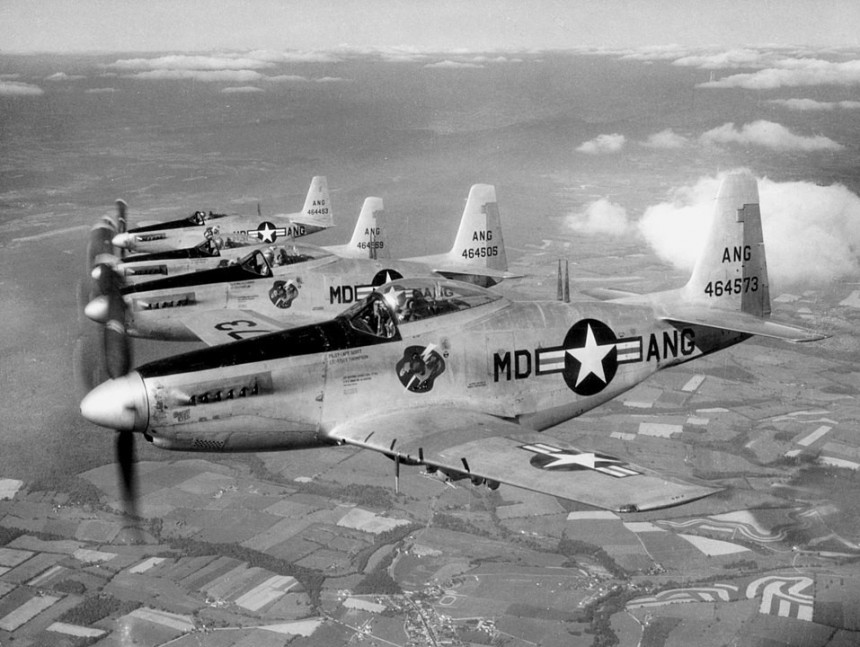The North American P-51 Mustang is an iconic airplane synonymous with its service in World War II. But to say its development ceased entirely once the war came to a close would not be entirely accurate. Had the war gone on just a little bit longer, the skies over Germany and Japan may have been filled with the little-known ultimate Mustang.
If you're familiar with the P-51 Mustang, the chances are pretty good you're the most familiar with the P-51D variant. Sporting a Packard manufactured license copy of the Roll-Royce Merlin engine. The P-51D is a mythical-status airplane known the world over. But it wasn't the ultimate Mustang, not even close. The P-51H model, had it seen service in the war, would've no doubt scared the living daylights out of the Luftwaffe.
The P-51H project was the brainchild of North American Aviation engineer Edgar Schmued. While on a trip to England in February 1943, Schmued visited the Supermarine and Rolls Royce factories there to learn more about how they managed to build their Mk IX Spitfire and the Rolls-Royce Merlin 66 engine therein substantially stronger and more powerful without adding any significant weight.
Schmued took the advice from Supermarine and began making changes to its airframe. By the time it was finalized, the new, lightweight Mustang prototype only bore a familial resemblance to the ever-present P-51D. The end result was an airframe a full 600 pounds (272.1 kg) lighter than the P-51D. Dubbed the XP-51F, XP-51G, and XP-51J, these three prototypes consolidated into the first production order from the U.S. Army Air Corps for 1,000 airframes.
On first impressions alone, the P-51H looks much the same as any P-51D you'd find in any World War Two movie worth it's salt. Rest assured, the P-51H is an entirely bespoke and separate airframe. One that took the best aspects of the P-51D and amplified them to the utmost degree. It had a longer fuselage, a shorter landing gear, and a more refined version of North America's famous laminar flow wing.
Apart from a few superficial items, almost no parts on the P-51H had any backward compatibility with the P-51D. Its landing gear braking system consisted of steel disks instead of drums, a radical new technology in the day. Further, the belly scoop inlet was now curved instead of square like the original P-51s.
Under the proverbial hood of the ultimate Mustang is an even further upgraded version of the V-1650 Merlin engine, the -9 variant. This engine came standard with a Simmons automatic boost control mechanism with water injection for its unique and innovative dual-stage, dual-speed supercharger. At full war-emergency power, it was a combo good enough for 2,218 horsepower at takeoff.
The results were dramatic. Where the P-51D could only consistently crack 450 miles per hour (724 kph) in a dive, the P-51H could manage this in level flight or even a mild climb. There are even reports that these P-51H models topped 472 miles per hour (760 km/h; 410 km) at 21,200 ft (6,500 m). A new, wider Aeroproducts 11-inch quad-blade Unimatic propeller was employed to wrangle as much air through its blades as possible while in flight.
As for weapons, the Mustangs made consistent use of a six M2 50. cal machine gun arrangement throughout its service with the American Army Air Corps and is largely much the same in the P-51H. What's changed, however, is the redesigned ammo boxes. With overhauled ammo doors that seldom impeeded firing operations, the P-51H could reload faster without breaking the famous laminar airflow over its wings.
The P-51H took to the air for the first time on February 3rd, 1945, with North American Aviation test pilot Bob Chilton. It promptly crashed three days later due to prop failure. Some Pacific Theater American squadrons received their P-51Hs before the Imperial Japanese Surrender in August 1945. But these units never saw combat service. Ironically, during the Korean war of 1950 to 53, the P-51D Mustang the H was supposed to replace was called into service while the H itself was not.
In total, over 550 P-51H airframes left NAA's Inglewood factory in Los Angeles County, California, ending in November 1945. Most airframes were handed to the state Air National Guards across the country. Today, only five P-51 airframes are known to still exist. Two are on permanent museum static display, two are airworthy, and a further airframe is currently undergoing a full restoration to airworthy status.
Check back soon for more from Limited Edition Month
The P-51H project was the brainchild of North American Aviation engineer Edgar Schmued. While on a trip to England in February 1943, Schmued visited the Supermarine and Rolls Royce factories there to learn more about how they managed to build their Mk IX Spitfire and the Rolls-Royce Merlin 66 engine therein substantially stronger and more powerful without adding any significant weight.
Schmued took the advice from Supermarine and began making changes to its airframe. By the time it was finalized, the new, lightweight Mustang prototype only bore a familial resemblance to the ever-present P-51D. The end result was an airframe a full 600 pounds (272.1 kg) lighter than the P-51D. Dubbed the XP-51F, XP-51G, and XP-51J, these three prototypes consolidated into the first production order from the U.S. Army Air Corps for 1,000 airframes.
On first impressions alone, the P-51H looks much the same as any P-51D you'd find in any World War Two movie worth it's salt. Rest assured, the P-51H is an entirely bespoke and separate airframe. One that took the best aspects of the P-51D and amplified them to the utmost degree. It had a longer fuselage, a shorter landing gear, and a more refined version of North America's famous laminar flow wing.
Under the proverbial hood of the ultimate Mustang is an even further upgraded version of the V-1650 Merlin engine, the -9 variant. This engine came standard with a Simmons automatic boost control mechanism with water injection for its unique and innovative dual-stage, dual-speed supercharger. At full war-emergency power, it was a combo good enough for 2,218 horsepower at takeoff.
The results were dramatic. Where the P-51D could only consistently crack 450 miles per hour (724 kph) in a dive, the P-51H could manage this in level flight or even a mild climb. There are even reports that these P-51H models topped 472 miles per hour (760 km/h; 410 km) at 21,200 ft (6,500 m). A new, wider Aeroproducts 11-inch quad-blade Unimatic propeller was employed to wrangle as much air through its blades as possible while in flight.
As for weapons, the Mustangs made consistent use of a six M2 50. cal machine gun arrangement throughout its service with the American Army Air Corps and is largely much the same in the P-51H. What's changed, however, is the redesigned ammo boxes. With overhauled ammo doors that seldom impeeded firing operations, the P-51H could reload faster without breaking the famous laminar airflow over its wings.
In total, over 550 P-51H airframes left NAA's Inglewood factory in Los Angeles County, California, ending in November 1945. Most airframes were handed to the state Air National Guards across the country. Today, only five P-51 airframes are known to still exist. Two are on permanent museum static display, two are airworthy, and a further airframe is currently undergoing a full restoration to airworthy status.
Check back soon for more from Limited Edition Month
